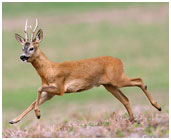Deer are found across the globe, except for a few areas. Through this article, we acquaint you with some interesting facts & amazing information on deer.
Facts About Deer
Deer, a beautiful animal, is found inhabiting all the continents of the world, with the exception of Antarctica and Australia. In fact, even Africa has only one native species of deer, known as the Red Deer. It mainly inhabits the Atlas Mountains, located in the northwest of the continent. Deer are very adaptable creatures, the reason why they can be found in a number of habitats. They can be divided into four sub-families, namely Capreolinae/Odocoileinae, Cervinae, Hydropotinae and Muntiacinae, and boast of a large number of species. To get some more interesting facts and amazing information on deer, read on.

Facts about Deer
Kingdom: Animalia
Phylum: Chordata
Class: Mammalia
Order: Artiodactyla
Suborder: Ruminantia
Family: Cervidae
Subfamilies: Four
Diet: Herbivorous
Natural Habitat: All continents, except Antarctica and Australia
Age: 11 years
Gestation Period: Up to 10 months
Number of Offspring: 1 to 2
Interesting & Amazing Information on Deer
- Depending on the species, male deer are known as stags, harts, bucks or bulls, while the females are called hinds, does or cows.
- Young deer are called fawns or calves, while a group of deer is commonly known as a herd.
- Deer have been found to inhabit a variety of biomes, ranging from tundra to the tropical rainforest.
- Deer mark their home range with a strongly scented pheromone. It is present in almost all the species of deer, in the facial gland present in the front of each eye.
- Fawns are born with fur, which is covered with white spots. The spots usually disappear as they get older (except in case of Fallow Deer).
- A fawn starts taking its first steps hardly 20 minutes after being born.
- Except for the Chinese water deer, all male deer have antlers. These antlers are shed and re-grown every year.
- There is only species of deer in which the female also has antlers, namely Reindeer (Caribou).
- During the mating season, male deer fight one another, with the help of their antlers, in order to attract mates in a given herd.
- Each of the species of deer has an antler structure that is different from the others.
- A number of Norwegian municipalities, namely Gjemnes, Hitra, Hjartdal and Voss, have a stag or stag's head in their arms.
- A deer appears on the arms of the Israeli Postal Authority.
- The antlers of deer are the fastest growing living tissue on earth.
- Deer have a great sense of hearing and can even move their ears in any direction, without moving the head.
- The eyes of deer, being situated on the sides of their head, afford them a 310 degree view.
- Deer have an excellent sense of smell and can detect predators from a long distance away.
- The breeding season of deer is usually between October and January.
- Since fawns do not have a scent, they remain undetected by the enemies.
- Deer raise their tails, as a sign of warning to others.
- Deer usually eat grass, leaves, stems, shoots, berries, herbs, acorns, mushrooms, wild fruit and agriculture crops, like corn and soy beans.
- Deer become less active in winters and this way, they survive on only one third of the diet they normally eat.
- Deer have hollow strands of hair that help them remain insulated from extremes of temperature and also prevent them from drowning.
- Deer belong to Artiodactyle order, meaning they have hoofs with even number of toes.


See also
More from iloveindia.com
- Home Remedies | Ayurveda | Vastu | Yoga | Feng Shui | Tattoos | Fitness | Garden | Nutrition | Parenting | Bikes | Cars | Baby Care | Indian Weddings | Festivals | Party ideas | Horoscope 2015 | Pets | Finance | Figures of Speech | Hotels in India : Delhi | Hyderabad | Chennai | Mumbai | Kolkata | Bangalore | Ahmedabad | Jaipur
- Contact Us Careers Disclaimer Privacy Policy Advertise With Us Lifestyle Sitemap Copyright iloveindia.com. All Rights Reserved.





